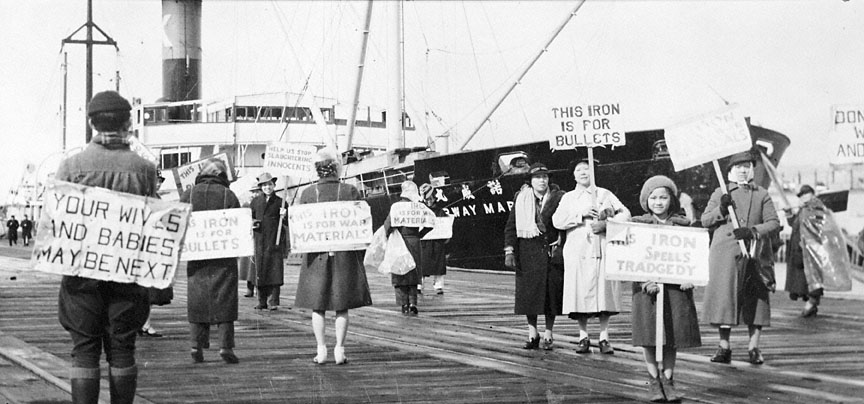This photograph of Chinese Americans picketing at the Port of Astoria appeared in the Oregon Journal on March 3, 1939. The picket was organized to protest the sale of scrap iron and steel to Japan, where it was recycled into war material. At the time of the protest, the Japanese government was waging an undeclared war against China. In 1939 approximately 2,000,000 tons of scrap metal were exported from the United States to Japan.
Chinese Americans in Astoria first announced their intention to picket the loading of scrap iron onto the Norway Maru, a large Japanese freighter, on February 21, 1939. When the ship arrived at port three days later, several dozen men, women, and children carried signs protesting the shipment of iron for use by the Japanese military. Three gangs of longshoremen that were dispatched to load the ship, refused to cross the picket line.
Convinced that the longshoremen had violated their contract by refusing to cross the picket, the Waterfront Employers Association threatened to close the port unless the ship was loaded, but the longshoremen ignored the order. To avoid the cessation of all business, the Port Authority of Astoria agreed to stop all future shipments of scrap if the picketers ended their protest. The compromise offer was accepted, and on March 4th, the ship, destined for Japan, was loaded with approximately 758 tons of scrap.
While workers loaded the Norway Maru in Astoria, Portland’s Chinese American community began a similar protest at the Port of Portland, where roughly 7,500 tons of scrap metal were to be loaded onto two Greek freighters, the Ann Stathatos and Kostia, both bound for Japan. As happened in Astoria, assigned longshoremen refused to cross the picket. A federal waterfront arbitrator, Samuel B. Weinstein, found the longshoremen in violation of their contract and ordered them to load the scrap, but they refused. Again, the Waterfront Employers Association responded to the work refusal by threatening to close the entire port unless the scrap was loaded. Not wanting to inconvenience the entire city by a port closure, the leaders of the protest called off the picket, convinced that they had accomplished their goal of raising public awareness of the problem.
At the time, U. S. trade with Japan was controlled by a 1911 treaty which Congress was unwilling to circumvent with an embargo. In July of 1940, Congress gave President Franklin D. Roosevelt the authorization to subject defense industry exports to a licensing program that would, in effect, create an embargo of those goods to Japan. Shortly after Japan invaded Indo-China (now Vietnam) in September of 1940, President Roosevelt used his new authority to impose a de facto embargo on scrap iron and steel to Japan. The embargo went into effect on October 16, 1940, and Japan turned toward Central and South America to support their continued needs for scrap metals.
Written by Joshua Binus, © Oregon Historical Society, 2004.
